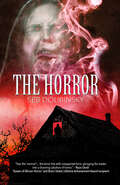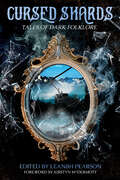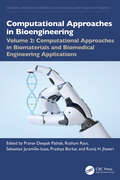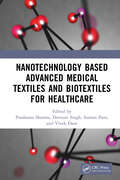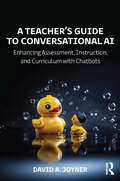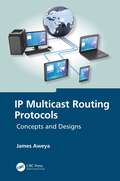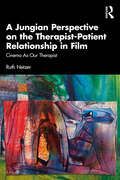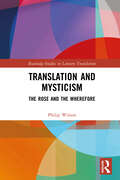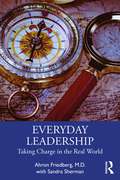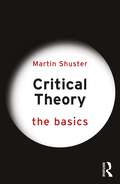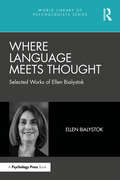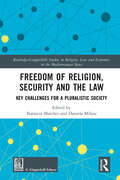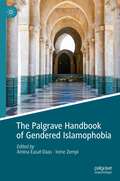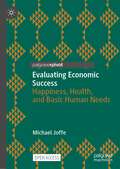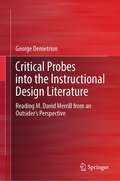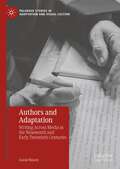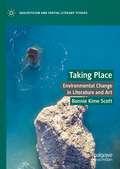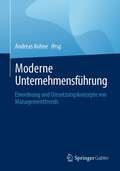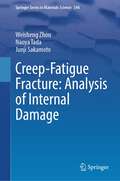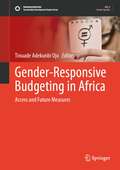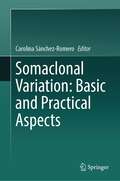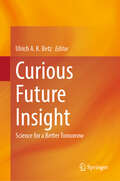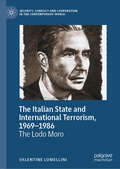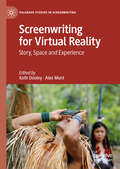- Table View
- List View
The Horror
by Seb DoubinskyWhen a famous horror writer arrives in a lovely coast town to work on his new novel, he is immediately seduced by its picturesque beauty and friendly locals. It looks like he finally found the ideal place to concentrate after a difficult and stressful period of his life. But when strange and frightening events begin to happen all around him, he begins to wonder if behind the beautiful facade of reality lurk some well-hidden and much darker secrets— or, maybe worse, if he' s purely and simply losing his mind?
Cursed Shards: Tales of Dark Folklore
by Leife Shallcross Clare Rhoden Nikky Lee Leanbh Pearson Louise Pieper Kirsten McDermott Mendel Mire K. B. Elijah McKenzie Richardson Amber M. Simpson Stephen HerczegBe careful what you wish for... We' ve all heard childhood fairy tales and hearthside stories passed from generation to generation warning us of unseen dangers lurking in the dark forest, the glimpse of a future in watery reflections and to be wary of objects and people offering impossible gifts. The Fae are ageless beings dwelling between light and shadow, stalking the moonlit nights and wielding powerful gifts and curses. Welcome to Cursed Shards, a collection of dark fantasy stories inspired by folklore, legends, fairy tales and mythology. Ten authors spin ten different tales ranging from deserts, icy mountains and dark forests to legendary warriors to the mythical Fae. A realm where the landscape is as volatile as the rulers and an ancient cursed mirror, a once-powerful magical artefact created with blood magic was shattered before it could be used against the realm. A cursed mirror broken but never destroyed. Ten shards remain: now disguised and repurposed into ordinary items that are traded, stolen, and sold between rulers, common folk and the Fae. Whenever a shard re-appears its curse influences the decisions of all who come within reach threatening Fae and mortal kingdoms alike.Here, the ancient adage ‘ be careful what you wish for' is true.
Computational Approaches in Biomaterials and Biomedical Engineering Applications (Emerging Trends in Biomedical Technologies and Health informatics)
by Sebastián Jaramillo-Isaza Roshani Raut Pranav Deepak Pathak Pradnya Borkar Rutvij H. JhaveriComputational Approaches in Bioengineering, Volume 2—Computational Approaches in Biomaterials and Biomedical Engineering Applications is a comprehensive and up-to-date resource that provides a broad overview of the use of computational methods in the fields of biomaterials and biomedical engineering. Written by a team of experts in the field of biomaterials and biomedical engineering, it provides a wealth of information on the use of computational methods in these fields. Furthermore, it explores emerging trends and discusses future directions and associated limitations in the field. Through thorough exploration and explanation, it showcases the latest research and advancements, offering valuable insights into how computational methods are utilized to design and optimize biomaterials, simulate biological processes, and develop innovative medical devices.FEATURES Provides practical guidance and real-world examples to help readers apply computational approaches effectively in their work Explores the diverse computational approaches employed in biomaterials and biomedical engineering applications, offering a comprehensive view of the field Introduces emerging topics and cutting-edge techniques, keeping wide range of readers at the forefront of advancements in computational bioengineering Discusses the integration of computational methods in biomaterials and biomedical engineering, fostering a deeper understanding of their synergistic potential Provides a valuable resource for researchers, practitioners, and students alike, serving as a comprehensive guide to computational approaches in biomaterials and biomedical engineering applications The book is well-organized and easy to read. The chapters are written in a clear and concise style, and they provide a comprehensive overview of the topics covered. The book is also well-illustrated with figures and tables that help to explain the concepts discussed in the text. With its comprehensive coverage, practical examples, and expert insights, this book serves as a valuable resource for researchers, students, and professionals in the fields of biomaterials and biomedical engineering.
Nanotechnology Based Advanced Medical Textiles and Biotextiles for Healthcare
by Vivek Dave Prashansa Sharma Devsuni Singh Suman PantThis book provides systematic coverage of research into medical and biotextiles based on nanomaterials as applicable in healthcare. Divided into three sections, it explains manufacturing, properties, types, and recent developments in nanotechnology based medical textiles backed by case studies. It includes a wide range of different clinical applications of biotextiles for healthcare including nanotextile scaffolds, nano-based artificial organs, surgical sutures, enzymatic assisted enhanced biotextiles, tissue engineering or drug delivery system via nanofibers, and so forth.Features: Provides strong and broad overview of medical applications in the field of nano and biotextiles. Highlights different approaches, recent research, and emerging innovations. Covers designing or developing nanomaterials based antiviral surface disinfectants with self-cleaning property. Reviews different applications of nano based medical textiles such as deodorizing or pH control clothing for hygiene maintenance. Includes the real-life applications based descriptive case studies that offer a diverse range of perspectives. This book is aimed at researchers and graduate students in textile technology and engineering, and medical textiles.
A Teacher’s Guide to Conversational AI: Enhancing Assessment, Instruction, and Curriculum with Chatbots
by David A. JoynerA Teacher’s Guide to Conversational AI explores the practical role that language-based artificial intelligence tools play in classroom teaching, learning experiences, and student assessment. Today’s educators are well aware that conversational and generative AI—chatbots, intelligent tutoring systems, large language models, and more—represent a complex new factor in teaching and learning. This introductory primer offers comprehensive, novice-friendly guidance into the challenges and opportunities of incorporating AI into K-12 schools and college classes in ways that are appropriate, nourishing to students, and outcomes-driven.Opening with an informative overview of the foundational properties, key terminology, and ethical considerations of these tools, the book offers a coherent and realistic vision of classrooms that are enhanced, rather than stymied, by AI systems. This includes strategies for:· designing assessments that are conducive to students’ beneficial use of AI while mitigating overreliance or dishonesty;· using AI to generate lesson examples for student critique or custom content that reinforces course principles;· leveraging chatbots as a co-instructor or a tutor, a guide during student-driven learning, a virtual debate or brainstorming partner, and a design project; and· creating course content, lesson plans and activities, expanded language and accessibility options, and beyond. Through the depth of understanding and applied approach provided in these chapters, teachers and leaders in training and in service, alongside private tutors, college instructors, and other educators, will be better prepared to future-proof their efforts to serve new generations of learners.
IP Multicast Routing Protocols: Concepts and Designs
by James AweyaThis book discusses the fundamental concepts that are essential to understanding IP multicast communication. The material covers the well‑known IP multicast routing protocols, along with the rationale behind each protocol. The book starts with the basic building blocks of multicast communications and networks, then progresses into the common multicast group management methods used, and finally into the various, well‑known multicast routing protocols used in today’s networks. IP multicast provides significant benefits to network operators by allowing the delivery of information to multiple receivers simultaneously with less network bandwidth consumption than using unicast transmission. Applications that can benefit greatly from multicast communications and multicast‑enabled networks include audio and video conferencing, collaborative computing, online group learning and training, multimedia broadcasting, multi‑participant online gaming, and stock market trading. This book’s goal is to present the main concepts and applications, allowing readers to develop a better understanding of IP multicast communication. IP Multicast Routing Protocols: Concepts and Designs presents material from a practicing engineer’s perspective, linking theory and fundamental concepts to common industry practices and real‑world examples. The discussion is presented in a simple style to make it comprehensible and appealing to undergraduate‑ and graduate‑level students, research and practicing engineers, scientists, IT personnel, and network engineers. It is geared toward readers who want to understand the concepts and theory of IP multicast routing protocols, yet want these to be tied to clearly illustrated and close‑to‑real‑world example systems and networks.
A Jungian Perspective on the Therapist-Patient Relationship in Film: Cinema As Our Therapist
by Ruth NetzerWithin this book, Ruth Netzer explores the archetypal components of therapist-patient relations in cinema from the perspective of Jungian archetypal symbolism, and within the context of myth and ritual.Film is a medium that is attracted to the extremes of this specific relationship, depicting the collapse of the accepted boundaries of therapyp; though on the other hand, cinema also loves the fantasy of therapy as intimacy. Through the medium of film, and employing examples from over 45 well-known films, the author analyzes the successes and failures of therapists within film, and reviews the concepts of transference and counter-transference and their therapeutic and redemptive powers, in contrast to their potential for destruction and exploitation within the context of a patient-therapist relationship.This book will be a fascinating read for Jungian analysts, psychologists, psychiatrists, and therapists with an interest in the link between cinema and therapy, as well as filmmakers and students and teachers of film studies.
Translation and Mysticism: The Rose and the Wherefore (Routledge Studies in Literary Translation)
by Philip WilsonThis book examines how mysticism can tell us about translation and translation can tell us about mysticism, addressing the ancient but ongoing connections between the art of rendering one text in another language and the art of the ineffable.The volume represents the first sustained act of attention to the interdisciplinary crossover of these two fields, taking a Wittgensteinian approach to language, and investigates how mystics and their translators manage to write about what cannot be written about. Three questions are addressed overall: how mysticism can be used to conceptualise translation; the issues that mysticism raises for translation theory and practice; and how mystical texts have been and might be translated. Walter Benjamin’s ‘The Translator’s Task’ is considered in detail as a controversial example of dialogue. Translation examples are given in a range of languages, and six major case studies are provided, including a close reading of Exodus and an analysis of a recent radical translation of Lucretius. This book will be of interest to students and researchers in translation studies, mysticism studies, theology and literary translation, as well as practising translators.
Everyday Leadership: Taking Charge in the Real World
by Sandra Sherman Ahron Friedberg, M.D.Everyday Leadership examines how individuals in everyday, relatively small settings can succeed in leadership positions.The book provides tools for tackling the unique psychological and external challenges that everyday leaders face, and offers principles that they can adapt to their own situations. Dr. Ahron Friedberg, who regularly advises leaders and would-be leaders, emphasizes the social aspect of leadership, and explores how those who are new to leadership – and those in established positions – can leverage their support networks and thrive in their roles. The book follows the experience of real people who have faced leadership challenges and learned from them, demonstrating how readers can learn from these examples and apply them to their own circumstances. Guided by a practical leadership roadmap, chapters examine concepts such as vision, determination, flexibility, planning, organization, and responsibility using extensive case studies, with reflective questions and key takeaways that help the reader consider how to apply these principles to their own leadership challenges.This book is an essential read for HR professionals, executive coaches, management consultants, leadership trainers, and organizational psychologists as well as those facing leadership challenges in their profession.
Critical Theory: The Basics (The Basics)
by Martin ShusterCritical Theory: The Basics brings clarity to a topic that is confusingly bandied about with various meanings today in popular and academic culture.First defined by Max Horkheimer in the 1930s, “critical theory” now extends far beyond its original German context around the Frankfurt School and the emergence of Nazism. We now often speak of critical theories of race, gender, anti-colonialism, and so forth. This book introduces especially the core program of the first-generation of the Frankfurt School (including Horkheimer, Theodor W. Adorno, Erich Fromm, and Herbert Marcuse), and shows how this program remains crucial to understanding the problems, ideologies, and systems of the modern world, including capitalism, racism, sexism, and the enduring problems of colonialism. It explores basic questions like: What is critical theory? What can critical theory be? What should it be? Why and how does critical theory remain vital to understanding the contemporary world, including notions of self, society, politics, art, religion, culture, race, gender, and class? With suggestions for further reading, this book is an ideal starting point for anyone seeking an accessible but robust introduction to the richness and complexity of this tradition and to its continuing importance today.
Where Language Meets Thought: Selected Works of Ellen Bialystok (World Library of Psychologists)
by Ellen BialystokIn the World Library of Psychologists series, international experts present career-long collections of what they judge to be their most interesting publications – extracts from books, key articles, research findings, and practical and theoretical contributions.Ellen Bialystok has published widely in the field of cognitive development and decline across the lifespan. Her research uses behavioral and neuroimaging methods to examine the effect of experience on cognitive and brain systems with a focus on bilingualism. Her discoveries include the identification of differences in the development of cognitive and language abilities for monolingual and bilingual children, the use of different brain networks by monolingual and bilingual young adults performing cognitive tasks, and the postponement of symptoms of dementia in bilingual older adults. In other studies, she has investigated the effects of bilingual education on children’s development and the cognitive and brain consequences of bilingualism in older adults.Including a specially written introduction, in which Ellen Bialystok reflects on the role that language plays on thought, this collection will serve as a valuable resource for students and researchers of psycholinguistics, developmental psychology, and applied linguistics.
Freedom of Religion, Security and the Law: Key Challenges for a Pluralistic Society (Routledge-Giappichelli Studies in Religion, Law and Economics in the Mediterranean Space)
by Natascia Marchei Daniela MilaniThis collection addresses many of the issues arising from the management of religious and cultural diversity in a multicultural society and refers to the complex relationship between the right to religious freedom and security. In recent decades, and particularly since September 2001, the right to religious freedom, which has hitherto been widely protected, has come up against a significant challenge in terms of security, or rather, in the subjectively and publicly perceived feelings of security. This book collects original theoretical, legal and comparative contributions addressing several implications for the right to freedom of religion or belief through the lens of security. It offers a new key to understanding how to manage the processes of integration of religious diversity in multifaith societies. Written by leading experts in the area, the work reveals the importance of avoiding simplistic conclusions and unfounded prejudices about religious freedom, and of limiting restrictive or repressive interventions to situations of genuine danger. The book will be an essential resource for researchers, academics and policy-makers working in the areas of Law and Religion, Human Rights Law and Security Studies.
The Palgrave Handbook of Gendered Islamophobia
by Irene Zempi Amina Easat-DaasAgainst a backdrop of continually growing global Islamophobia, this handbook provides a comprehensive, interdisciplinary overview of the key issues, theories, debates, and developments in gendered Islamophobia, unpacking how Western, Orientalist constructions of Muslim men and women affect the lived experiences of Muslim men and women; impact social, legal, and criminological policies, practices, and discourse; and give rise to resistance against gendered Islamophobia. Drawing on theories from philosophy, sociology, gender studies, psychology and criminology, sections examine the interdisciplinary theoretical dimensions of gendered Islamophobia; illustrate the dynamics of gendered Islamophobia through the use of case examples in the UK, Europe, North America, Australasia, the Middle East, and South Asia. This handbook will be valuable reading for scholars, researchers, and policymakers around the globe in Gender Studies, Sociology, Criminology, Politics, and Law, whofocus on the intersections of gender and Islamopobia, and the impact on Muslim men and women respectively.
Evaluating Economic Success: Happiness, Health, and Basic Human Needs (Wellbeing in Politics and Policy)
by Michael JoffeThis open access book argues that a new policy approach is required in order to tackle the numerous problems the world is currently facing. The priority should be on achieving better outcomes for people, especially those facing deprivation or precariousness, by meeting their basic needs. In order to achieve this, the book develops a monitoring system that can act as an objective, an incentive, and a criterion of success for policy makers at all levels of government and in civil society, as well as providing information to guide specific actions. In doing so, the book aims to promote good health and positive social functioning by providing a new approach to help assess how well basic human needs are being met. This involves monitoring the outcomes of the economy that ought to satisfy these needs. It will appeal to all those interested in public policy, official statistics and monitoring, public health and wellbeing, as well as practitioners.
Critical Probes into the Instructional Design Literature: Reading M. David Merrill from an Outsider’s Perspective
by George DemetrionThis book provides a comprehensive study of the work of M. David Merrill, a major pioneer in the field of instructional design. This book centers on his research on his second generation instructional design (ID2) theory, Instructional Transaction Theory, and First Principles of Instruction, which has had a substantial impact on the instructional design field. It’s appealing to the instructional design research and practitioner-based communities who can draw on specific sections of this book to enhance their own work. It is also intended for those seeking to learn more about the relationship between the instructional design field, learning theory, curriculum studies, and lifelong learning/adult education studies. Through this critical, yet empathetic study of Merrill’s 50+ year research agenda, this book provides an illuminating field of entry into a broad range of topics, both those that are central to Merrill’s own research agenda, and into areas that extend well beyond his essentially cognitivist epistemological assumptions.
Authors and Adaptation: Writing Across Media in the Nineteenth and Early Twentieth Centuries (Palgrave Studies in Adaptation and Visual Culture)
by Annie NissenThis book studies British literary writers’ engagement with adaptations of their work across literary, theatrical, and film media in the nineteenth and early twentieth centuries. It considers their critical, reflective, and autobiographical writings about the process of adaptation, and traces how their work was shaped, as well as delimited, by their involvement with adaptations to different media and intermedial writing. Linking canonical and non-canonical writers both chronologically and contemporaneously, and bridging studies of prose fiction adaptation from nineteenth-century theatre to early twentieth-century film, this book offers an interdisciplinary, transhistorical, cultural, and analytical study of adaptation and the variable positions of writers within and across media.
Taking Place: Environmental Change in Literature and Art (Geocriticism and Spatial Literary Studies)
by Bonnie Kime ScottTaking Place: Environmental Change in Literature and Art explores how works of literature and art help us to rethink the ways that we have perceived, imagined, inhabited, explored, conquered, and shared places. The book offers chapters on India, Southern Africa, Ireland, Australia, and New York City. The literary and artistic works investigated range in time from early indigenous rock art to contemporary literary representations of place. Bonnie Kime Scott participates in ongoing interdisciplinary discussions of ecocritical, feminist, postcolonial, post-humanist and place studies.
Moderne Unternehmensführung: Einordnung und Umsetzungskonzepte von Managementtrends
by Andreas KohneIn diesem Buch erläutern erfahrene Experten aktuelle und erfolgskritische Managementthemen und geben damit eine wichtige Orientierungshilfe für Geschäftsführer und C-Levels. In den letzten Jahren wurden Firmenlenker vor viele Herausforderungen gestellt. Allerorts entstehen neue Buzzwords und Trends: Wirtschaftliche Krisen, New Work und hybrides Arbeiten, Fachkräftemangel und Mitarbeitergesundheit, Nachhaltigkeitsansätze sowie die immer schneller voranschreitende Digitalisierung müssen individuell für jedes Unternehmen analysiert, bewertet und angegangen werden, um weiterhin erfolgreich zu sein.Die Autoren, jeweils Spezialisten in ihrem Bereich, bieten in diesem Werk konkrete Lösungsansätze für Themen wie Service Mindset, hybriden Vertrieb, New Work, Agilität, Cyber-Security, Resilienz oder E-Knowledge. Außerdem enthält das Buch prägnante Statements und Einschätzungen einer Vielzahl von Experten aus verschiedenen Branchen. Abgerundet wird es durch ein ausführlichesInterview mit dem bekannten Zukunftsforscher Prof. Dr. Thomas Druyen, in dem vor allem die Auswirkungen der Künstlichen Intelligenz (KI) auf eine moderne Unternehmensführung beleuchtet werden.
Creep-Fatigue Fracture: Analysis of Internal Damage (Springer Series in Materials Science #344)
by Junji Sakamoto Weisheng Zhou Naoya TadaThis book presents a detailed analysis of the processes of internal damage and healing of damage in high-temperature creep-fatigue. This analysis is based on experimental results and a three-dimensional visualization and simulation method. It focuses on inner cracking type fracture, which is essential to consider for creep-fatigue in actual equipment and structures used at high temperatures for long periods of time. In this book, systematic studies of the fracture are presented by introducing three-dimensional simulation and visualization methods. This book is for designers and researchers in industry specializing in strength of materials at high temperatures. It is also for a postgraduate or higher academic audience specializing in mechanical engineering and materials science engineering. In reading the book it is expected that readers will acquire knowledge of evaluation techniques for high-temperature creep-fatigue damage. In addition, this book allows readers toimprove the accuracy of damage evaluation, design materials for longer lifetimes, and apply the described techniques to other materials.
Gender-Responsive Budgeting in Africa: Access and Future Measures (Sustainable Development Goals Series)
by Tinuade Adekunbi OjoAfrica is the leading region in the world in the expansion of mobile money transactions, according to Global Findex. The book presents several significant themes and African states' efforts to address the political and economic factors influencing budget allocation to women-oriented programmes and projects in African communities. The book further investigates the impact of gender-responsive budgeting on women's empowerment and gender equality in these communities. The findings intend to analyse the effectiveness of the countries' approaches and share lessons that different African economies, whether currently booming or struggling, can enhance or implement toward gender budgeting response at all structural levels. Gender budgeting is an important tool in response to the growth and development of the economy. The themes identified will guide gender budgeting response, and how gender is incorporated into these approaches (if at all). The main objective of this volumeis to understand different processes of gender budgeting in response to gender issues at a national level. And to help encourage reflection on what lessons could be learnt between states and what factors cause divergence in multilateral settings so that they can be understood and hopefully addressed.
Somaclonal Variation: Basic and Practical Aspects
by Carolina Sánchez-RomeroThis book is fundamental for plant biotechnologists at this moment, due to the extensive use of in vitro culture. Although some books about somaclonal variation were published some years ago, the circumstances in this field have undergone a great change in the last years. Much progress has been achieved in plant in vitro culture: new technologies have been developed, previously used protocols have been modified with regard to optimization, and in vitro techniques have been applied to new species. Besides, tools for somaclonal variation analysis have also changed in the last years. The techniques and instruments have substantially improved, with the development of new molecular markers and the increased precision and sensitivity of some instruments. Furthermore, novel knowledge about the basic mechanisms underlying somaclonal variation has been obtained recently, which can be very useful for explaining the variability found in different experimental systems.Therefore, it is evident that information about basic and practical aspects of somaclonal variation requires updating and the proposed book is a very good means for this purpose.
Alternate Dispute Resolution Systems
by P. JaganathanThe Arbitration and Conciliation Act, 1996, aims to facilitate the resolution of disputes in international trade and commerce through streamlined and accessible means. It effectively promotes arbitration as a primary method of alternative dispute resolution, ensuring minimal court interference. By prioritizing efficiency and convenience, the Act provides a robust framework that supports the swift and fair settlement of commercial conflicts, aligning with global standards and enhancing the attractiveness of arbitration for international parties. This legislative approach underscores the commitment to fostering a favorable environment for international trade and commerce.
Curious Future Insight: Science for a Better Tomorrow
by Ulrich A. K. BetzThis book follows up the debate on the future of science and technology at the Curious2022 – Future Insight Conference, the second event in this conference series initiated on the occasion of Merck’s 350th anniversary. In the chapters, some of the world’s top scientists, managers and entrepreneurs explore breakthrough technologies and how they can be applied to make a better world for humanity. The book begins with an introduction to the vision of the conference “United by science for a better tomorrow” and the impacts caused by the pandemic, highlighting the importance of gathering like-minded people to discuss and support the advancement of science and technology for the benefit of humanity. In the first part of the book, readers will also find a chapter written by the Executive Board of Merck KGaA discussing the importance of curiosity for innovation and an overview of the company’s contribution in the areas of life sciences, healthcare and electronics forward-moving the scientific discovery. The second part of the book offers insights of some of the scientific topics discussed at the conference, and particular attention is given to new therapies and sustainability. In the final part of the book, readers will find some thoughts on ethical principles guiding our application of science and technology to create a bright future for humanity, and diverse perspectives on topics such as health, life sciences, nutrition, material sciences, digitalization, AI, energy, mobility, space flight, robotics, the secrets of the human mind and new ways of working together. Given its interdisciplinary appeal, the book will inspire curiosity in a wide readership, from scholars and researchers to professionals with an interest in exploring the future of science and technology, solving the problems of today, and paving the way for a better tomorrow. Chapters 1 and 2 are available open access under a Creative Commons Attribution 4.0 International License via link.springer.com
The Italian State and International Terrorism, 1969–1986: The Lodo Moro (Security, Conflict and Cooperation in the Contemporary World)
by Valentine LomelliniThis book sheds light on the so-called ‘Moro Doctrine’, an Italian state security policy which has been portrayed in literature as an under-the-counter agreement made between Italy and Palestinian movement during the Cold War. The Moro Doctrine, or ‘Lodo Moro’ as it is known in Italy, aimed to protect the peninsula from Palestinian attacks by allowing terrorists to use Italian territory as a base for weapons and guerrilla fighters.Responsibility for the ‘Lodo’ was instrumentally placed on Aldo Moro, the five- time Prime Minister of Italy, after his death, and since then his name has become indelibly linked with the shame of having negotiated with Palestinian terrorists.Thanks to records collected from over twenty archives in Italy, the USA, France, Germany, Britain and Russia, concrete evidence shows that the significance of this agreement needs to be rethought. The author argues that the decision to adopt the Lodo was not solely made by Moro, but also involved key figures of the Christian Democrat and Socialist parties, various magistrates and even the President of the Republic. It illustrates how terrorism was used as an effective tool in international diplomacy to influence foreign and domestic policies.Offering a re-examination of Italian counter-terrorist policy, this book analyses how Italy responded to international terrorism during the Cold War, providing a useful read for those researching Italian and European history, Cold War studies, the history of international relations and diplomacy, and Middle-East history.
Screenwriting for Virtual Reality: Story, Space and Experience (Palgrave Studies in Screenwriting)
by Kath Dooley Alex MuntThis book is focused on screenwriting and development for virtual reality (VR). It explores a diverse range of creative approaches to the writing and screen development of VR stories and immersive audience experiences. Contributions from scholars and practitioners combine conceptual and practically orientated approaches for creating fictional and documentary media VR stories. The book evaluates, challenges and adapts existing screenwriting models and practices for immersive storytelling and grapples with the future of storytelling in the era of sophisticated computer visualization, AI and the online social metaverse. The book proposes new VR storytelling models, identifies altered relationships between creators, screen works and their audiences and demonstrates how interdisciplinary practices will be core to the future of screen storytelling.
